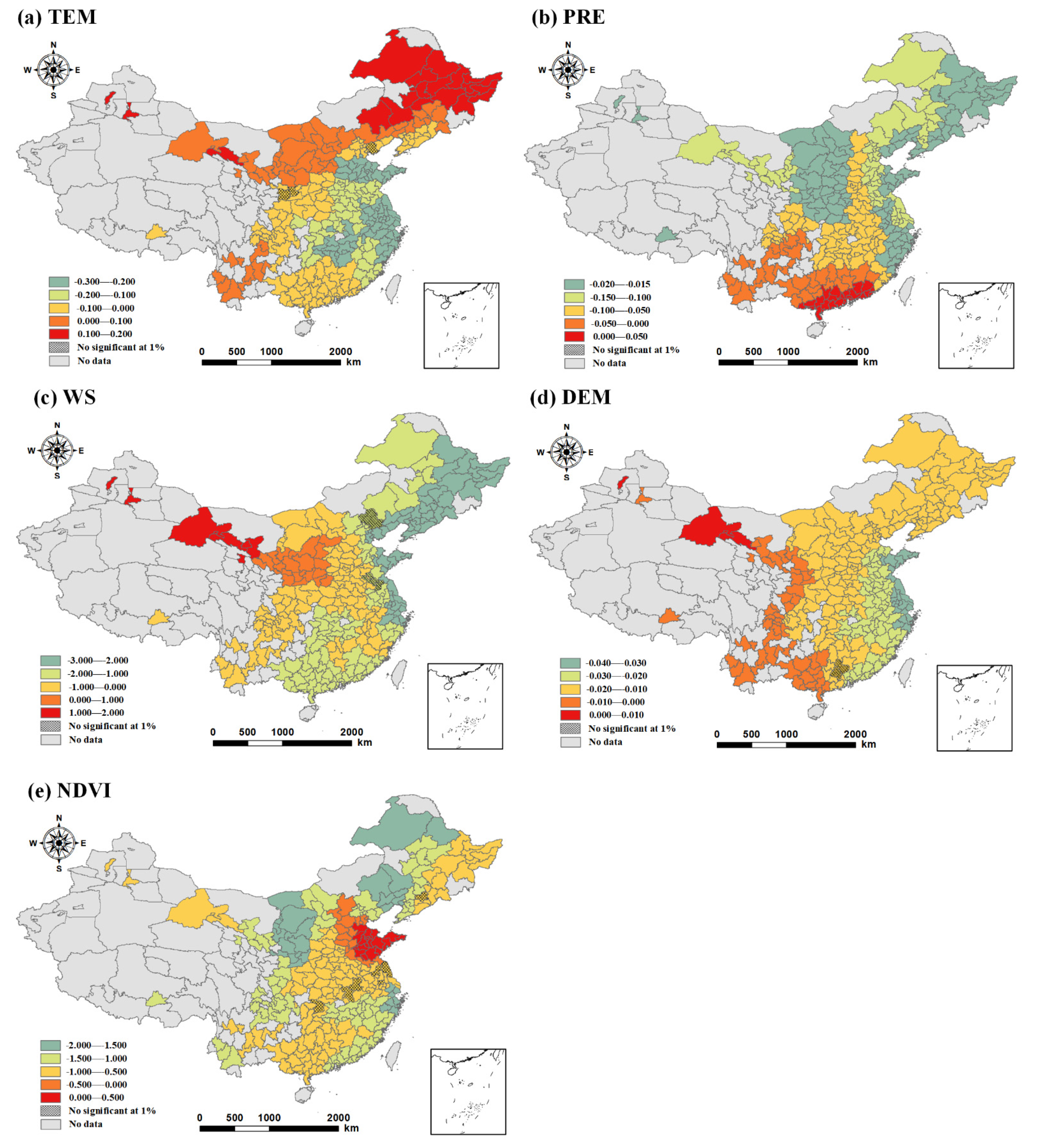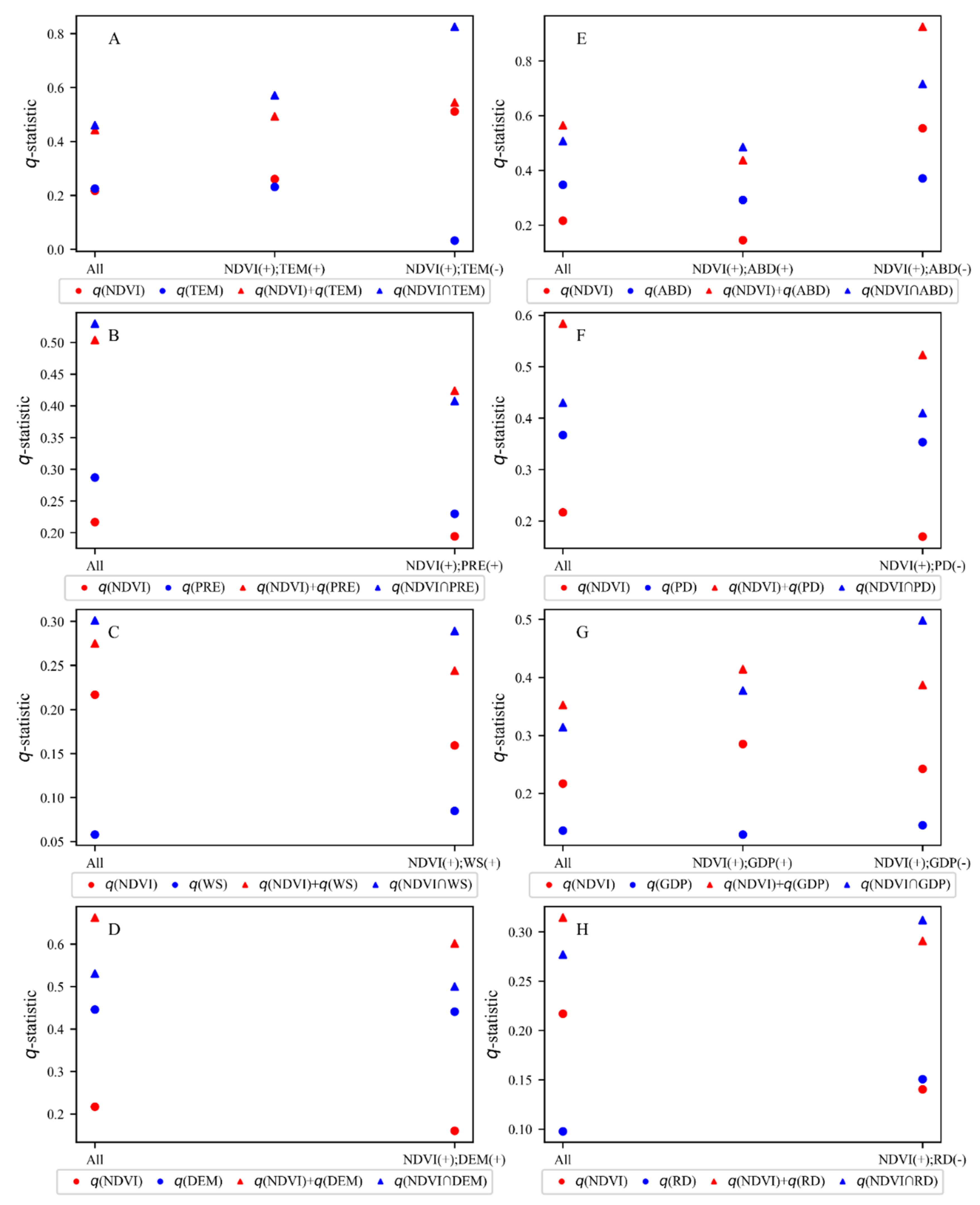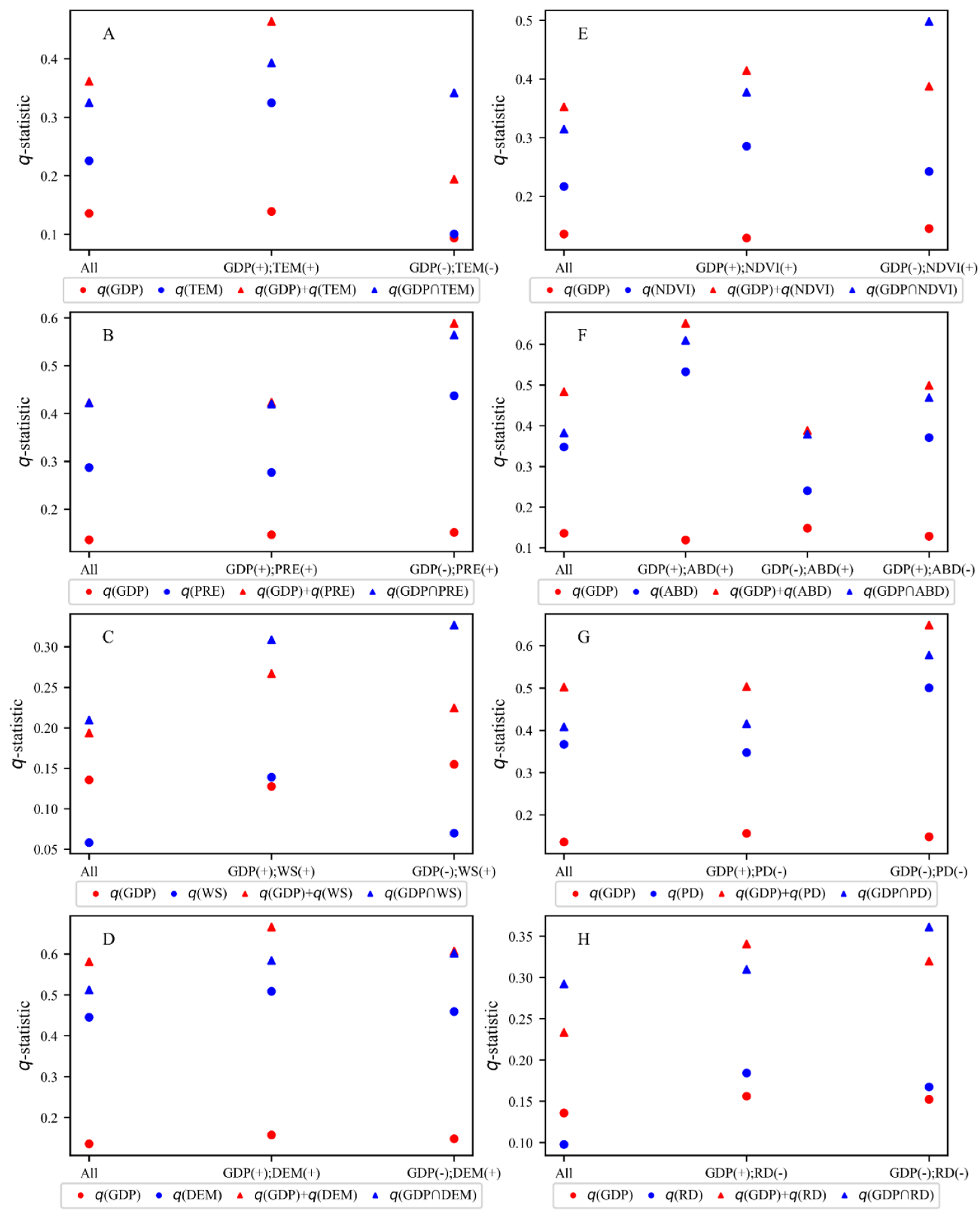Assessing Spatial Heterogeneity of Factor Interactions on PM2.5 Concentrations in Chinese Cities
Abstract
:1. Introduction
2. Data and Methods
2.1. Data
2.1.1. PM2.5 Concentration Data
2.1.2. Meteorological Data
2.1.3. Topography Data
2.1.4. Socioeconomic Factors
2.2. Multi-Scale Geographically Weighted Regression
2.3. Geographical Detector Model
3. Results
3.1. Spatial Variation Characteristics of PM2.5 Concentrations
3.2. Global Influence of Driving Factors on PM2.5 Concentrations
3.3. Spatial Heterogeneity of Influence of Driving Factors
3.4. Spatial Heterogeneity of Interactions between Driving Factors
4. Discussion
5. Conclusions
Author Contributions
Funding
Institutional Review Board Statement
Informed Consent Statement
Acknowledgments
Conflicts of Interest
Appendix A. Local Moran’s Test





References
- Lelieveld, J.; Evans, J.S.; Fnais, M.; Giannadaki, D.; Pozzer, A. The contribution of outdoor air pollution sources to premature mortality on a global scale. Nature 2015, 525, 367–371. [Google Scholar] [CrossRef]
- Liu, J.; Diamond, J. China’s environment in a globalizing world. Nature 2005, 435, 1179. [Google Scholar] [CrossRef]
- Wang, C.; Lin, Z. Environmental Policies in China over the Past 10 Years: Progress, Problems and Prospects. Procedia Environ. Sci. 2010, 2, 1701–1712. [Google Scholar]
- Guo, H.; Cheng, T.; Gu, X.; Wang, Y.; Chen, H.; Bao, F.; Shi, S.; Xu, B.; Wang, W.; Zuo, X. Assessment of PM2.5 concentrations and exposure throughout China using ground observations. Sci. Total Environ. 2017, 601–602, 1024–1030. [Google Scholar] [CrossRef] [PubMed]
- Chen, Z.; Cai, J.; Gao, B.; Xu, B.; Dai, S.; He, B.; Xie, X. Detecting the causality influence of individual meteorological factors on local PM2.5 concentration in the Jing-Jin-Ji region. Sci. Rep. 2017, 7, 40735. [Google Scholar] [CrossRef] [Green Version]
- Fang, C.; Zhou, C.; Gu, C.; Chen, L.; Li, S. A proposal for the theoretical analysis of the interactive coupled effects between urbanization and the eco-environment in mega-urban agglomerations. J. Geogr. Sci. 2017, 27, 1431–1449. [Google Scholar] [CrossRef]
- Han, X.; Li, H.; Liu, Q.; Liu, F.; Arif, A. Analysis of influential factors on air quality from global and local perspectives in China. Environ. Pollut. 2019, 248, 965–979. [Google Scholar] [CrossRef]
- Nowak, D.J.; Hirabayashi, S.; Bodine, A.; Hoehn, R. Modeled PM2.5 removal by trees in ten US cities and associated health effects. Environ. Pollut. 2013, 178, 395–402. [Google Scholar] [CrossRef] [PubMed]
- James Gauderman, W.; McConnell, R.O.B.; Gilliland, F.; London, S.; Thomas, D.; Avol, E.; Vora, H.; Berhane, K.; Rappaport, E.B.; Lurmann, F. Association between air pollution and lung function growth in southern California children. Am. J. Respir. Crit. Care Med. 2000, 162, 1383–1390. [Google Scholar] [CrossRef] [Green Version]
- Hvidtfeldt, U.A.; Sørensen, M.; Geels, C.; Ketzel, M.; Khan, J.; Tjønneland, A.; Overvad, K.; Brandt, J.; Raaschou-Nielsen, O. Long-term residential exposure to PM2.5, PM10, black carbon, NO2, and ozone and mortality in a Danish cohort. Environ. Int. 2019, 123, 265–272. [Google Scholar] [CrossRef] [PubMed]
- Han, L.; Zhou, W.; Li, W. Increasing impact of urban fine particles (PM 2.5) on areas surrounding Chinese cities. Sci. Rep. 2015, 5, 12467. [Google Scholar]
- Bei, N.; Zhao, L.; Wu, J.; Li, X.; Feng, T.; Li, G. Impacts of sea-land and mountain-valley circulations on the air pollution in Beijing-Tianjin-Hebei (BTH): A case study. Environ. Pollut. 2018, 234, 429–438. [Google Scholar] [CrossRef] [PubMed]
- Yun, G.; Zuo, S.; Dai, S.; Song, X.; Xu, C.; Liao, Y.; Zhao, P.; Chang, W.; Chen, Q.; Li, Y.; et al. Individual and Interactive Influences of Anthropogenic and Ecological Factors on Forest PM2.5 Concentrations at an Urban Scale. Remote Sens. 2018, 10, 521. [Google Scholar] [CrossRef] [Green Version]
- Wang, X.; Dickinson, R.E.; Su, L.; Zhou, C.; Wang, K. PM2.5 pollution in China and how it has been exacerbated by terrain and meteorological conditions. Bull. Am. Meteorol. Soc. 2018, 99, 105–119. [Google Scholar] [CrossRef]
- Li, P.; Yan, R.; Yu, S.; Wang, S.; Liu, W.; Bao, H. Reinstate regional transport of PM2.5 as a major cause of severe haze in Beijing. Proc. Natl. Acad. Sci. USA 2015, 112, E2739–E2740. [Google Scholar] [CrossRef] [Green Version]
- Zhou, C.; Chen, J.; Wang, S. Examining the effects of socioeconomic development on fine particulate matter (PM2.5) in China’s cities using spatial regression and the geographical detector technique. Sci. Total Environ. 2018, 619, 436–445. [Google Scholar] [CrossRef]
- Zhu, L.; Hao, Y.; Lu, Z.-N.; Wu, H.; Ran, Q. Do economic activities cause air pollution? Evidence from China’s major cities. Sustain. Cities Soc. 2019, 49, 101593. [Google Scholar] [CrossRef]
- Sá, E.; Tchepel, O.; Carvalho, A.; Borrego, C. Meteorological driven changes on air quality over Portugal: A KZ filter application. Atmos. Pollut. Res. 2015, 6, 979–989. [Google Scholar] [CrossRef]
- Calkins, C.; Ge, C.; Wang, J.; Anderson, M.; Yang, K. Effects of meteorological conditions on sulfur dioxide air pollution in the North China plain during winters of 2006–2015. Atmos. Environ. 2016, 147, 296–309. [Google Scholar] [CrossRef]
- Yang, D.; Wang, X.; Xu, J.; Xu, C.; Lu, D.; Ye, C.; Wang, Z.; Bai, L. Quantifying the influence of natural and socioeconomic factors and their interactive impact on PM2.5 pollution in China. Environ. Pollut. 2018, 241, 475–483. [Google Scholar] [CrossRef]
- Wang, Y.; Liu, C.; Wang, Q.; Qin, Q.; Ren, H.; Cao, J. Impacts of natural and socioeconomic factors on PM2.5 from 2014 to 2017. J. Environ. Manag. 2021, 284, 112071. [Google Scholar] [CrossRef] [PubMed]
- Wang, J.; Wang, S.; Li, S. Examining the spatially varying effects of factors on PM2.5 concentrations in Chinese cities using geographically weighted regression modeling. Environ. Pollut. 2019, 248, 792–803. [Google Scholar] [CrossRef] [PubMed]
- Yan, M.; Liu, J.; Wang, Z.; Ning, L. Biogeophysical impacts of land use/land cover change on 20th century anthropogenic climate compared to the impacts of greenhouse gas change. Int. J. Climatol. 2020, 40, 6560–6573. [Google Scholar] [CrossRef] [Green Version]
- Zou, Q.; Shi, J. The heterogeneous effect of socioeconomic driving factors on PM2.5 in China’s 30 province-level administrative regions: Evidence from Bayesian hierarchical spatial quantile regression. Environ. Pollut. 2020, 264, 114690. [Google Scholar] [CrossRef]
- Gu, K.; Zhou, Y.; Sun, H.; Dong, F.; Zhao, L. Spatial distribution and determinants of PM 2.5 in China’s cities: Fresh evidence from IDW and GWR. Environ. Monit. Assess. 2021, 193, 1–22. [Google Scholar] [CrossRef]
- Chen, J.; Zhou, C.; Wang, S.; Hu, J. Identifying the socioeconomic determinants of population exposure to particulate matter (PM2.5) in China using geographically weighted regression modeling. Environ. Pollut. 2018, 241, 494–503. [Google Scholar] [CrossRef] [PubMed]
- Brunsdon, C.; Fotheringham, A.S.; Charlton, M.E. Geographically weighted regression: A method for exploring spatial nonstationarity. Geogr. Anal. 1996, 28, 281–298. [Google Scholar] [CrossRef]
- Brunsdon, C.; Fotheringham, S.; Charlton, M. Geographically weighted regression. J. R. Stat. Soc. Ser. D (Stat.) 1998, 47, 431–443. [Google Scholar] [CrossRef]
- Fotheringham, A.S.; Brunsdon, C.; Charlton, M. Geographically Weighted Regression: The Analysis of Spatially Varying Relationships; John Wiley & Sons: Chichester, UK, 2003. [Google Scholar]
- Fotheringham, A.S.; Crespo, R.; Yao, J. Geographical and temporal weighted regression (GTWR). Geogr. Anal. 2015, 47, 431–452. [Google Scholar] [CrossRef] [Green Version]
- Fotheringham, A.S.; Yang, W.; Kang, W. Multiscale Geographically Weighted Regression (MGWR). Ann. Am. Assoc. Geogr. 2017, 107, 1247–1265. [Google Scholar] [CrossRef]
- Van Donkelaar, A.; Martin, R.V.; Brauer, M.; Hsu, N.C.; Kahn, R.A.; Levy, R.C.; Lyapustin, A.; Sayer, A.M.; Winker, D.M. Global estimates of fine particulate matter using a combined geophysical-statistical method with information from satellites, models, and monitors. Environ. Sci. Technol. 2016, 50, 3762–3772. [Google Scholar] [CrossRef] [PubMed]
- Lu, D.; Xu, J.; Yang, D.; Zhao, J. Spatio-temporal variation and influence factors of PM2.5 concentrations in China from 1998 to 2014. Atmos. Pollut. Res. 2017, 8, 1151–1159. [Google Scholar] [CrossRef]
- Leung, D.M.; Tai, A.P.K.; Mickley, L.J.; Moch, J.M.; Donkelaar, A.V.; Shen, L.; Martin, R.V. Synoptic meteorological modes of variability for fine particulate matter (PM 2.5) air quality in major metropolitan regions of China. Atmos. Chem. Phys. 2018, 18, 6733–6748. [Google Scholar] [CrossRef] [Green Version]
- Seo, J.; Park, D.-S.R.; Kim, J.Y.; Youn, D.; Lim, Y.B.; Kim, Y. Effects of meteorology and emissions on urban air quality: A quantitative statistical approach to long-term records (1999–2016) in Seoul, South Korea. Atmos. Chem. Phys. 2018, 18, 16121–16137. [Google Scholar] [CrossRef] [Green Version]
- Hutchinson, M.F. Interpolation of rainfall data with thin plate smoothing splines. Part I: Two dimensional smoothing of data with short range correlation. J. Geogr. Inf. Decis. Anal. 1998, 2, 139–151. [Google Scholar]
- Hutchinson, M.F.; Xu, T. Anusplin version 4.2 user guide. Cent. Resour. Environ. Stud. Aust. Natl. Univ. Canberra 2004, 54, 5–13. [Google Scholar]
- Wu, C.-D.; Chen, Y.-C.; Pan, W.-C.; Zeng, Y.-T.; Chen, M.-J.; Guo, Y.L.; Lung, S.-C.C. Land-use regression with long-term satellite-based greenness index and culture-specific sources to model PM2.5 spatial-temporal variability. Environ. Pollut. 2017, 224, 148–157. [Google Scholar] [CrossRef]
- Hu, Y.; Dong, Y. An automatic approach for land-change detection and land updates based on integrated NDVI timing analysis and the CVAPS method with GEE support. ISPRS J. Photogramm. Remote Sens. 2018, 146, 347–359. [Google Scholar] [CrossRef]
- Jia, T.; Zhang, X.; Dong, R. Long-Term Spatial and Temporal Monitoring of Cyanobacteria Blooms Using MODIS on Google Earth Engine: A Case Study in Taihu Lake. Remote Sens. 2019, 11, 2269. [Google Scholar] [CrossRef] [Green Version]
- Gorelick, N.; Hancher, M.; Dixon, M.; Ilyushchenko, S.; Thau, D.; Moore, R. Google Earth Engine: Planetary-scale geospatial analysis for everyone. Remote Sens. Environ. 2017, 202, 18–27. [Google Scholar] [CrossRef]
- Jin, Y.; Liu, X.; Yao, J.; Zhang, X.; Zhang, H. Mapping the annual dynamics of cultivated land in typical area of the Middle-lower Yangtze plain using long time-series of Landsat images based on Google Earth Engine. Int. J. Remote Sens. 2020, 41, 1625–1644. [Google Scholar] [CrossRef]
- Kumar, L.; Mutanga, O. Google Earth Engine applications since inception: Usage, trends, and potential. Remote Sens. 2018, 10, 1509. [Google Scholar] [CrossRef] [Green Version]
- Tsai, Y.H.; Stow, D.; Chen, H.L.; Lewison, R.; An, L.; Shi, L. Mapping vegetation and land use types in fanjingshan national nature reserve using google earth engine. Remote Sens. 2018, 10, 927. [Google Scholar] [CrossRef] [Green Version]
- Jin, Y.; Liu, X.; Chen, Y.; Liang, X. Land-cover mapping using Random Forest classification and incorporating NDVI time-series and texture: A case study of central Shandong. Int. J. Remote Sens. 2018, 39, 8703–8723. [Google Scholar] [CrossRef]
- Kan, H.; Chen, R.; Tong, S. Ambient air pollution, climate change, and population health in China. Environ. Int. 2012, 42, 10–19. [Google Scholar] [CrossRef]
- Barker, H.W. Isolating the industrial contribution of PM2.5 in Hamilton and Burlington, Ontario. J. Appl. Meteorol. Climatol. 2013, 52, 660–667. [Google Scholar] [CrossRef]
- Lou, C.-R.; Liu, H.-Y.; Li, Y.-F.; Li, Y.-L. Socioeconomic drivers of PM2.5 in the accumulation phase of air pollution episodes in the Yangtze River Delta of China. Int. J. Environ. Res. Public Health 2016, 13, 928. [Google Scholar] [CrossRef] [Green Version]
- Mataveli, G.A.; Silva, M.E.; França, D.D.; Brunsell, N.A.; de Oliveira, G.; Cardozo, F.D.; Bertani, G.; Pereira, G. Characterization and Trends of Fine Particulate Matter (PM2.5) Fire Emissions in the Brazilian Cerrado during 2002–2017. Remote Sens. 2019, 11, 2254. [Google Scholar] [CrossRef] [Green Version]
- Gao, L.; Tian, Y.; Zhang, C.; Shi, G.; Hao, H.; Zeng, F.; Shi, C.; Zhang, M.; Feng, Y.; Li, X. Local and long-range transport influences on PM2.5 at a cities-cluster in northern China, during summer 2008. Particuology 2014, 13, 66–72. [Google Scholar] [CrossRef]
- Xu, B.; Lin, B. Regional differences of pollution emissions in China: Contributing factors and mitigation strategies. J. Clean. Prod. 2016, 112, 1454–1463. [Google Scholar] [CrossRef]
- Hutcheson, G.D. Ordinary least-squares regression. SAGE Dict. Quant. Manag. Res. 2011, 224–228. [Google Scholar] [CrossRef] [Green Version]
- Li, Z.; Fotheringham, A.S.; Oshan, T.M.; Wolf, L.J. Measuring bandwidth uncertainty in multiscale geographically weighted regression using akaike weights. Ann. Am. Assoc. Geogr. 2020, 110, 1500–1520. [Google Scholar] [CrossRef]
- Oshan, T.M.; Smith, J.P.; Fotheringham, A.S. Targeting the spatial context of obesity determinants via multiscale geographically weighted regression. Int. J. Health Geogr. 2020, 19, 1–17. [Google Scholar] [CrossRef]
- Liu, Q.; Wu, R.; Zhang, W.; Li, W.; Wang, S. The varying driving forces of PM2.5 concentrations in Chinese cities: Insights from a geographically and temporally weighted regression model. Environ. Int. 2020, 145, 106168. [Google Scholar] [CrossRef] [PubMed]
- Yang, X.; Wang, S.; Zhang, W.; Zhan, D.; Li, J. The impact of anthropogenic emissions and meteorological conditions on the spatial variation of ambient SO2 concentrations: A panel study of 113 Chinese cities. Sci. Total Environ. 2017, 584–585, 318–328. [Google Scholar] [CrossRef] [PubMed]
- Wang, J.; Ogawa, S. Effects of Meteorological Conditions on PM2.5 Concentrations in Nagasaki, Japan. Int. J. Environ. Res. Public Health 2015, 12, 9089–9101. [Google Scholar] [CrossRef]
- Wei, L.A.; Yza, B.; Ping, L.C. Numerical simulation of the influence of major meteorological elements on the concentration of air pollutants during rainfall over Sichuan Basin of China. Atmos. Pollut. Res. 2020, 11, 2036–2048. [Google Scholar]
- Wu, T.; Zhou, L.; Jiang, G.; Meadows, M.E.; Zhang, J.; Pu, L.; Wu, C.; Xie, X. Modelling Spatial Heterogeneity in the Effects of Natural and Socioeconomic Factors, and Their Interactions, on Atmospheric PM2.5 Concentrations in China from 2000–2015. Remote Sens. 2021, 13, 2152. [Google Scholar] [CrossRef]
- Wu, W.; Zhang, M.; Ding, Y. Exploring the effect of economic and environment factors on PM2.5 concentration: A case study of the Beijing-Tianjin-Hebei region. J. Environ. Manag. 2020, 268, 110703. [Google Scholar] [CrossRef]









| Category | Factors | Abbreviation | Spatial Resolution | Data Sources |
|---|---|---|---|---|
| Meteorology | Temperature | TEM | Site-based | Chinese Meteorological Science Data Center (CMDC) |
| Precipitation | PRE | Site-based | CMDC | |
| Air pressure | AP | Site-based | CMDC | |
| Wind speed | WS | Site-based | CMDC | |
| Relative humidity | RH | Site-based | CMDC | |
| Topography | Elevation | DEM | 30 m | ASTER GDEM |
| NDVI | NDVI | 250 m | National Aeronautics and Space Administration (NASA) | |
| Social economy | Area of built districts | ABD | Prefecture- level | China Statistical Yearbook (CSY)/China City Statistical Yearbook (CCSY) |
| Population density | PD | Prefecture- level | CSY/CCSY | |
| GDP | GDP | Prefecture- level | CSY/CCSY | |
| Road density | RD | Prefecture- level | CSY/CCSY |
| Variables | Coefficient | VIF | Variables | Coefficient | VIF |
|---|---|---|---|---|---|
| Intercept | 7.729 *** | 1.046 | NDVI | −0.749 * | 1.069 |
| TEM | −0.051 *** | 1.046 | ABD | −0.001 ** | 2.389 |
| PRE | −0.006 *** | 1.102 | PD | 0.039 *** | 1.050 |
| WS | −0.637 *** | 1.031 | GDP | 0.118 *** | 2.099 |
| DEM | −0.010 *** | 1.128 | RD | 0.440 *** | 1.030 |
| Models | R2 | Adjusted R2 | AIC | AICc | RSS |
|---|---|---|---|---|---|
| OLS | 0.680 | 0.673 | 396.235 | 401.847 | 92.633 |
| MGWR | 0.835 | 0.829 | 348.663 | 356.920 | 70.215 |
| Variable | Min | Max | Median | Mean | Std | Bandwidth (km) |
|---|---|---|---|---|---|---|
| Intercept | 7.274 | 8.031 | 7.652 | 7.691 | 0.504 | 12 |
| TEM | −0.295 | 0.187 | −0.063 | −0.059 | 0.061 | 178 |
| PRE | −0.019 | 0.005 | −0.012 | −0.010 | 0.097 | 121 |
| WS | −2.874 | 1.617 | −0.670 | −0.652 | 0.066 | 163 |
| DEM | −0.037 | 0.006 | −0.014 | −0.015 | 0.011 | 281 |
| NDVI | −1.892 | 0.454 | −0.801 | −0.773 | 0.212 | 72 |
| ABD | −0.028 | 0.017 | −0.005 | −0.002 | 0.055 | 149 |
| PD | −0.010 | 0.076 | 0.035 | 0.031 | 0.033 | 230 |
| GDP | −0.561 | 0.780 | 0.129 | 0.122 | 0.196 | 87 |
| RD | −0.117 | 0.962 | 0.424 | 0.428 | 0.117 | 111 |
| TEM | PRE | WS | DEM | NDVI | ABD | PD | GDP | |
|---|---|---|---|---|---|---|---|---|
| PRE | 1;1;2 | - | - | - | - | - | - | - |
| WS | 2;2;1 | 2;2;1 | - | - | - | - | - | - |
| DEM | 2;2 | 1;2 | 1;1 | - | - | - | - | - |
| NDVI | 2;2 | 2;1 | 2;1 | 1;2 | - | - | - | - |
| ABD | 1 | 1 | 1 | 1 | 1 | - | - | - |
| PD | 1;1;2 | 1;2;2 | 2;2;2 | 1;2 | 1;2 | 1 | - | - |
| GDP | 1;2 | 1;2 | 2;1 | 1;2 | 1;2 | 1 | 1;1 | - |
| RD | 1 | 1 | 2 | 1 | 1 | 1 | 1 | 2 |
Publisher’s Note: MDPI stays neutral with regard to jurisdictional claims in published maps and institutional affiliations. |
© 2021 by the authors. Licensee MDPI, Basel, Switzerland. This article is an open access article distributed under the terms and conditions of the Creative Commons Attribution (CC BY) license (https://creativecommons.org/licenses/by/4.0/).
Share and Cite
Jin, Y.; Zhang, H.; Shi, H.; Wang, H.; Wei, Z.; Han, Y.; Cong, P. Assessing Spatial Heterogeneity of Factor Interactions on PM2.5 Concentrations in Chinese Cities. Remote Sens. 2021, 13, 5079. https://doi.org/10.3390/rs13245079
Jin Y, Zhang H, Shi H, Wang H, Wei Z, Han Y, Cong P. Assessing Spatial Heterogeneity of Factor Interactions on PM2.5 Concentrations in Chinese Cities. Remote Sensing. 2021; 13(24):5079. https://doi.org/10.3390/rs13245079
Chicago/Turabian StyleJin, Yuhao, Han Zhang, Hong Shi, Huilin Wang, Zhenfeng Wei, Yuxing Han, and Peitong Cong. 2021. "Assessing Spatial Heterogeneity of Factor Interactions on PM2.5 Concentrations in Chinese Cities" Remote Sensing 13, no. 24: 5079. https://doi.org/10.3390/rs13245079
APA StyleJin, Y., Zhang, H., Shi, H., Wang, H., Wei, Z., Han, Y., & Cong, P. (2021). Assessing Spatial Heterogeneity of Factor Interactions on PM2.5 Concentrations in Chinese Cities. Remote Sensing, 13(24), 5079. https://doi.org/10.3390/rs13245079








